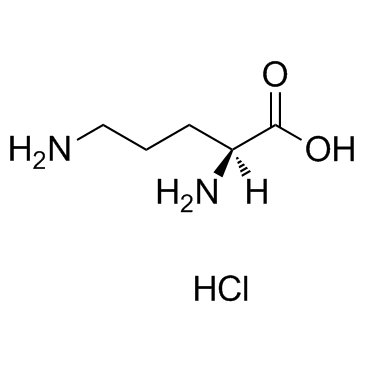L(+)-Ornithine hydrochloride

L(+)-Ornithine hydrochloride structure
|
Common Name | L(+)-Ornithine hydrochloride | ||
|---|---|---|---|---|
| CAS Number | 3184-13-2 | Molecular Weight | 168.622 | |
| Density | 1.57 | Boiling Point | 308.7ºC at 760 mmHg | |
| Molecular Formula | C5H13ClN2O2 | Melting Point | 245 °C (dec.)(lit.) | |
| MSDS | Chinese USA | Flash Point | 140.5ºC | |
|
Increased ornithine-derived polyamines cause airway hyperresponsiveness in a mouse model of asthma.
Am. J. Respir. Cell. Mol. Biol. 48(6) , 694-702, (2013) Up-regulation of arginase contributes to airways hyperresponsiveness (AHR) in asthma by reducing L-arginine bioavailability for the nitric oxide (NO) synthase isozymes. The product of arginase activity, L-ornithine, can be metabolized into polyamines by ornit... |
|
|
Microbacterium kyungheense sp. nov. and Microbacterium jejuense sp. nov., isolated from salty soil.
Int. J. Syst. Evol. Microbiol. 64(Pt 7) , 2267-73, (2014) Two novel strains, THG-C26(T) and THG-C31(T), were characterized using a polyphasic approach to determine their taxonomic positions. These two isolates were aerobic, Gram-stain-positive, non-motile, non-spore-forming and rod-shaped. 16S rRNA gene sequences an... |
|
|
Treatment of arginase deficiency revisited: guanidinoacetate as a therapeutic target and biomarker for therapeutic monitoring.
Dev. Med. Child Neurol. 56(10) , 1021-4, (2014) Hyperargininaemia is a disorder of the last step of the urea cycle. It is an autosomal recessive disease caused by deficiency of liver arginase-1 and usually presents later in childhood with progressive neurological symptoms including marked spasticity. In co... |
|
|
Disturbance of redox homeostasis by ornithine and homocitrulline in rat cerebellum: a possible mechanism of cerebellar dysfunction in HHH syndrome.
Life Sci. 93(4) , 161-8, (2013) Cerebellar ataxia is commonly observed in hyperornithinemia-hyperammonemia-homocitrullinuria (HHH) syndrome, an inherited metabolic disorder biochemically characterized by ornithine (Orn), homocitrulline (Hcit) and ammonia accumulation. Since the pathophysiol... |
|
|
Influence of environmental hypertonicity on the induction of ureogenesis and amino acid metabolism in air-breathing walking catfish (Clarias batrachus, Bloch).
Indian J. Exp. Biol. 52(7) , 728-38, (2014) Effect of environmental hypertonicity, due to exposure to 300 mM mannitol solution for 7 days, on the induction of ureogenesis and also on amino acid metabolism was studied in the air-breathing walking catfish, C. batrachus, which is already known to have the... |
|
|
A conformational sampling model for radical catalysis in pyridoxal phosphate- and cobalamin-dependent enzymes.
J. Biol. Chem. 289(49) , 34161-74, (2014) Cobalamin-dependent enzymes enhance the rate of C-Co bond cleavage by up to ∼10(12)-fold to generate cob(II)alamin and a transient adenosyl radical. In the case of the pyridoxal 5'-phosphate (PLP) and cobalamin-dependent enzymes lysine 5,6-aminomutase and orn... |
|
|
Discovery of an Iron-Regulated Citrate Synthase inStaphylococcus aureus
Chem. Biol. 19(12) , 1568-78, (2012) Bacteria need to scavenge iron from their environment, and this is no less important for bacterial pathogens while attempting to survive in the mammalian host. One key strategy is the synthesis of small iron chelators known as siderophores. The study of sider... |
|
|
Three-component lysine/ornithine decarboxylation system in Lactobacillus saerimneri 30a.
J. Bacteriol. 195(6) , 1249-54, (2013) Lactic acid bacteria play a pivotal role in many food fermentations and sometimes represent a health threat due to the ability of some strains to produce biogenic amines that accumulate in foods and cause trouble following ingestion. These strains carry speci... |
|
|
Diversity-oriented synthesis of azapeptides with basic amino acid residues: aza-lysine, aza-ornithine, and aza-arginine.
Org. Lett. 16(13) , 3588-91, (2014) Aza-peptides with basic amino acid residues (lysine, ornithine, arginine) and derivatives were synthesized by an effective approach featuring alkylation of a hydrazone-protected aza-glycine residue with α-bromo ω-chloro propane and butane to provide the corre... |
|
|
Are Enterococcus populations present during malolactic fermentation of red wine safe?
Food Microbiol. 42 , 95-101, (2014) The aim of this study was the genetic characterisation and safety evaluation of 129 Enterococcus isolates obtained from wine undergoing malolactic fermentation. Genetic characterisation by randomly amplified polymorphic DNA-PCR displayed 23 genotypes. 25 isol... |